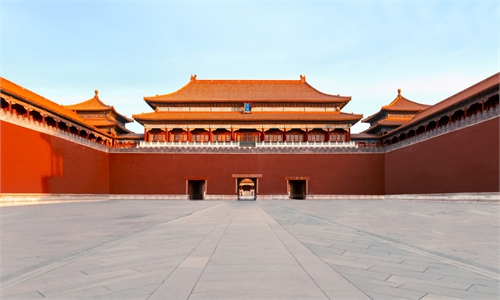ARTS / CULTURE & LEISURE
Palace Museum’s new northern branch set for October completion

The Academic Symposium on Inheritance and Legal Protection of Twentieth-century Architectural Heritage has commenced at the North China University of Technology on Thursday. Photo: Courtesy of the committee on 20th-century architectural heritage affiliated with the Chinese Cultural Relics Society
The highly anticipated new branch of Beijing's iconic Palace Museum is on track for completion in October, marking a milestone in China's cultural infrastructure development, the chief architect of the new museum said at an academic event on Thursday.
"The new branch will harmonize cutting-edge museum design with the 100-year-old Palace Museum's legacy while addressing long-standing challenges in artifact preservation and public access," Zhang Yu said at the Academic Symposium on Inheritance and Legal Protection of Twentieth-century Architectural Heritage, which commenced at the North China University of Technology on Thursday.
He outlined the project's innovative integration of traditional symbolism and modern technology.
"The three-dimensional design [of the new branch] employs symbolic representations of the Forbidden City's cultural DNA," he explained, noting that the layout features a central axis paying homage to the original palace complex while adopting contemporary "scattered-point composition" in its skyline design.
Internally, the facility prioritizes artifact security through rational zoning, streamlined visitor flow, and user-friendly spaces imbued with human-centric design principles.

The design blueprint for the northern branch of the Palace Museum Photo: Courtesy of Beijing Institute of Architectural Design
Environmental integration forms a core design philosophy, with the complex conceived as a "museum within a landscape."Architectural elements mirror the Forbidden City's signature vermilion walls and golden roofs through modern reinterpretation, while the surrounding gardens create a seamless transition between built environment and natural setting. Located in Xiyuhe village, Beijing's Haidian district - 30 kilometers from the Forbidden City - the northern branch will provide over 60,000 square meters of exhibition space and 35,000 square meters dedicated to advanced conservation laboratories, according to the museum.
The Forbidden City was China's royal palace from 1420 to 1911 during the Ming (1368-1644) and Qing (1644-1911) dynasties.
The year after China's last emperor, Puyi, left the royal residence in 1924, it became a public museum.
Thanks to its rich history and abundant imperial legacies, over 1.86 million cultural relics are now housed in the museum. These account for 40 percent of the country's highest-level cultural relics.
However, lack of exhibition spaces and outdated offices have long bothered administrators of the museum.
"Some ancient buildings just don't have the conditions for modern exhibitions," Zhang told the Global Times.
"From its inception, the northern branch has been designed to 21st-century international standards," Zhang told the Global Times, highlighting the significance of offering the nation's first public elective course on "20th-Century Architectural Heritage" at institutions like North China University of Technology.
He also highlighted sustainable development principles and state-of-the-art technologies in the new branch.
He added that "structural stability" stands as a defining feature of the Palace Museum's northern branch, with its massive and robust exterior embodying architectural solidity.
The complex will further incorporate over 300 seismic isolation and energy-dissipating components, enabling a multi-dimensional, multi-point composite shock absorption system to ensure resilience against earthquakes, CCTV reported.
Innovations include next-generation lighting systems balancing optimal display conditions with fire prevention measures crucial for safeguarding the world's largest collection of ancient wooden structures.
The architect extended an open invitation to global peers for post-completion academic exchanges, underscoring China's commitment to cultural heritage innovation.
The project traces its origins to 2013, when museum administrators, including then-director of the Palace Museum Shan Jixiang, first proposed satellite facilities to alleviate overcrowding and modernize operations.
A blueprint by the Beijing Institute of Architectural Design triumphed in the competition by artfully blending historical motifs with contemporary functionality.
Once operational, the branch will significantly enhance artifact conservation capabilities and public engagement opportunities, Zhang said.




